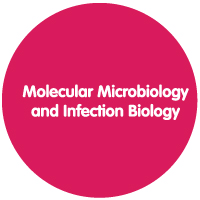 | | Microbial Cell and Development BiologyCoordinators
Adriano O. Henriques
Mariana Gomes de Pinho Objectives
Bacterial cells have long been viewed as “bags of enzymes” with randomly distributed macromolecules, such as proteins or DNA. Due to recent advances, particularly in fluorescence microscopy, we are now well aware that bacteria are highly organized organisms, with dynamic cytoskeletal structures, a chromosome with a defined
organization, many proteins with specific sub-cellular addresses, specialized organelles, and complex differentiation pathways, which include adventures into multicellularity.
The objective of the course is to guide the students through the discovery of the intricate and dynamic organization of microbial cells during growth and development.
An equally important objective is to foster the development of skills in (i) critical analysis and interpretation of scientific papers; (ii) writing clear, concise and logically argued essays in a specific topic of their choice and (iii) giving clear, effective, well timed oral presentations with appropriate visual support. Syllabus
A. Bacterial cell cycle and morphogenesis: i) cell cycle: organization and segregation of the bacterial chromosome; coordination between DNA segregation and cell division; ii) Cytoskeletal structures and cell morphogenesis:
bacterial homologues of tubulin, actin and intermediate filament proteins.
B. Principles and mechanisms of protein sub-cellular localization: i) the “first-to-arrive” problem: cues for protein localization ii) The assembly of prokaryotic organelles: membrane- and protein-bound organelles. Establishing cell
polarity.
C. Microbial development: i) microbial development in the context of earth´s natural history. Developmental programs in model organisms; social behavior and multicellular development; ii) Developmental biology of Bacillus subtilis: origin and evolution of sporulation. Developmental commitment. Compartmentalized gene expression. Morphological checkpoints. Structure and outputs of regulatory circuits. Impact of spores in biotechnology and biomedicine. Evaluation
Students will be evaluated based on their performance in an oral seminar and their active participation in the lectures and tutorials. Main Bibliography - “Cell Biology of Bacteria” L. Shapiro and R.M. Losick Eds (2011) CSHL Press.
- Adams, DW and J. Errington. 2009. Nat. Rev. Microbiol. 7:642-563.
- Alon, U. 2007. Nat. Rev. Genet. 8:450-461.
- Angert, ER. 2005. Nat. Rev. Microbiol. 3:214-224.
- Cabeen MT, and C Jacobs-Wagner. 2010. Annu. Rev. Genet. 44: 365-392.
- Dworkin, J. 2009. Cold Spring Harb Perspect Biol. 1:a003368.
- Errington J. 2003. Nat. Rev. Micro. 1:117–126.
- Flärdh, K, and M.J. Buttner. 2009. Nat. Rev. Microbiol. 7:36-49.
- Fuerst, JA., and E. Sagulenko. 2011. Nat. Rev. Microbiol. 9:403-413.
- Henriques, AO, and C. P. Moran Jr. 2007. Ann. Rev. Microbiol., 61:555-588.
- Paredes, CJ, KV Alsaker, and ET. Papoutsakis. 2005. Nat. Rev. Microbiol. 3:969-978.
- Scheffers DJ, and MG Pinho. 2005. Microbiol. Mol. Biol. Rev. 69: 585-607.
- Singh, SP, and BL Montgomery. 2011. Trends Microbiol. 19:278-285.
- Thanbichler, M and L Shapiro. 2006. J Struct Biol. 156:292-303.
- Velicer, GJ and M Vos. 2009. Annu. Rev. Microbiol. 63:599–623.
|

